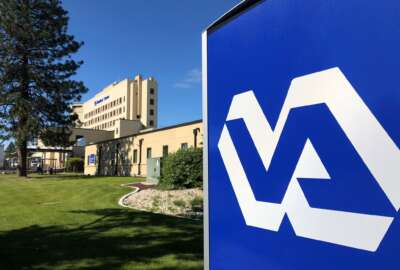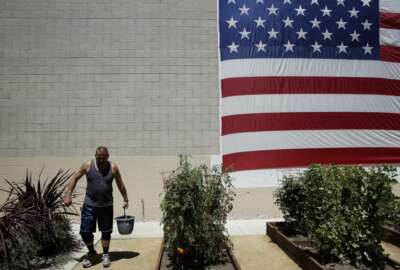

The Veterans Affairs Office of Inspector General is in the midst of a region-by-region look at how well its facilities perform their mission. No surprise, the COVID...
Best listening experience is on Chrome, Firefox or Safari. Subscribe to Federal Drive’s daily audio interviews on Apple Podcasts or PodcastOne.
The Veterans Affairs Office of Inspector General is in the midst of a region-by-region look at how well its facilities perform their mission. It’s something the IG does every three years. This time around, no surprise, the COVID pandemic is a big part of the look-see. In fact, inspectors themselves had to switch to online visits. For what they found so far, Federal Drive with Tom Temin turned to deputy assistant inspector general Mary Toy.
Interview transcript:
Tom Temin: Ms. Toy, good to have you one.
Mary Toy: Great, Tom, thank you for having me.
Tom Temin: And so in this round of rounds, you might say, to the different regional areas of VA, you have been doing this virtually, the inspection — tell us how that works.
Mary Toy: So because of the COVID-19 pandemic we did convert our scheduled July and September 2020 site visits for VISN (Veterans Integrated Service Networks) 10 and VISN 20 facilities to virtual reviews. We dropped our usual physical inspections with the physical rounds that are done for the environmental care review, and instead initiated an evaluation of COVID readiness and response instead. So to conduct these virtual reviews, we interviewed the facility leaders and staff by video teleconference, and gathered VA staffs feedback through an anonymous electronic survey. Our CHIP (Comprehensive Healthcare Inspection Program) SITE visits take about a week to complete. However, for these virtual reviews, we did allow extra time and other flexibilities for our teams to work with VHA facility leaders and staff because of their simultaneous health care priorities for our veterans and civilian patients.
Tom Temin: And were some video walkthroughs part of this, because I imagine you can pick up a lot of clues as to the condition of a place when you’re there and can see it, and frankly medical facilities can smell what’s going on.
Mary Toy: Right, right. So for the physical inspection process itself, we felt like it would not be fully comprehensive. And as a result, we did drop that review to create some capacity for us to evaluate their COVID readiness and response.
Tom Temin: Because I remember at one time, there was an emergency report a few years back on the D.C. Medical Center, and you had to see it to believe it because of the conditions and closets and so forth. I imagine that’s a rarity — you hope it is. But you don’t get that chance to peek inside a supply closet or a prescription dispensary.
Mary Toy: Correct. So we hope that now that the country is opening up again, that we will be returning to our physical on site inspection process within the next few months. So we’ll see how it goes, just waiting on CDC guidance and additional guidance from the Biden administration.
Tom Temin: And on a typical CHIP, Comprehensive Healthcare Inspection Program visit, how many people are involved from the Office of the Inspector General? How many people does it take to look at a visit in a regional area, which has many, many locations?
Mary Toy: So we usually cover about nine to ten topics of specific areas that shows how well the facility is operating and gives us a taste of what the quality of the care that’s provided. So we generally send a project leader and then four inspectors to evaluate one medical center or healthcare system.
Tom Temin: Just reading from the report, you look at five issue areas, emergency preparedness supplies, equipment, infrastructure, staffing, access to care and community living center patient care. Those five parameters. Did the COVID aspects overlay all of those things too this time?
Mary Toy: Correct. So this report focused on our results for only one of the nine topic areas that we covered during our CHIP reviews at these 13 facilities. So the subject areas that you just mentioned, focuses purely on the COVID review area that we looked at.
Tom Temin: Got it. And what were your general impressions then of how well they were responding to COVID?
Mary Toy: So with these 13 facilities, of course, the results were very individualized for each of them. Keeping in mind also that at the time of inspections, the facilities have not yet experienced the full force of the pandemic peaks that we subsequently saw this past November and December. But the leaders in the staff did have valuable information to share with us. Many of the facility leaders cited communication as key to effective preparations and several recognized leadership efforts on the part of VA central offices and their division offices in terms of providing the needed information and guidance. So for instance, for Ann Arbor, I’d like to highlight some results that we have in the report. For Ann Arbor, the facility managers trained healthcare personnel to decontaminate personal protective equipment, items like goggles and face shields and items that were needed by the intensive care unit. They also borrowed 10 ventilators from the University of Michigan during the early weeks of the pandemic and acquired additional ventilators in preparation for future waves. In terms of the hands on care that the facilities were providing in terms of surgery and outpatient clinic visits, the pandemic definitely affected those areas. The leaders reported adherence to the VISN VHA guidance about canceling elective procedures. And notably, at the time of inspections, all facilities had resumed elective procedures in varying capacity except for Spokane, Washington. The VA there had a backlog of semi-urgent surgeries that were still being addressed before they could even consider continuing elective procedures.
Tom Temin: We’re speaking with Mary Toy. She’s Deputy Assistant Inspector General at the Veterans Affairs Department. So you got the sense that the people were pretty honest with you that you were interviewing by video, I presume, of the challenges they faced and how they were able to respond to them?
Mary Toy: Yes, we did all of our interviews by video teleconference. We saw, sometimes, the nonverbal communication tells you so much more than what the words did. And they were sincere and honest, and we could see the stress on their faces. And then we kept the time constraints that they had in mind as we conducted this review.
Tom Temin: And do you think that this procedure, maybe doing a lot of the interviews remotely without all the travel and time it takes, and just the physical on site inspection of the physical plant, let’s say, eventually back in person, because you need to do that — is that gonna be maybe a new standard operating procedure for the OIG?
Mary Toy: Good question. We are working on how we might proceed in the new normal. The pandemic has forced us into looking at more creative ways of how we can accomplish our work and oversight mission. Certainly, so I’m smiling right now, because we are in some transition mode and we do envision there to be some changes. Perhaps sending a partial team out and having others stay behind to conduct their work virtually because it is certainly possible and more efficient use of government resources.
Tom Temin: Yes, it is efficient, both with resources and time of the individuals. But there’s got to be something important in the on-site visits, even for the interviews, I imagine that’s pretty hard to replicate any other way isn’t there?
Mary Toy: Definitely, we plan to go back and be on site in the very near future.
Tom Temin: And so you’ve done VISN 20 and 10. Sort of, I guess, the upper left corner of the country is a better way to put it. And what’s left to do now in this cycle?
Mary Toy: So during the last six months, we have continued our cyclical inspections virtually. And as scheduled, we plan to continue our assessments of the COVID-19 pandemic response and readiness. During this past time we have completed additional unannounced virtual reviews with VISN 19, which is the Rocky Mountain network. VISN 1, the New England healthcare system, as well as VISN 8, which is the VA Sunshine Healthcare Network. I don’t have any definitive to share yet. In regards to these inspections. Our teams are still analyzing the data, finalizing results and drafting reports that still have to be issued to these VA facilities for development of action plans that address our recommendations for improvement.
Tom Temin: So no recommendations yet, you’re just in data gathering mode.
Mary Toy: Exactly.
Tom Temin: Mary Toy is Deputy Assistant Inspector General at the Veterans Affairs Department. Thanks so much for joining me.
Mary Toy: Thank you, Tom.
Copyright © 2025 Federal News Network. All rights reserved. This website is not intended for users located within the European Economic Area.
Tom Temin is host of the Federal Drive and has been providing insight on federal technology and management issues for more than 30 years.
Follow @tteminWFED


